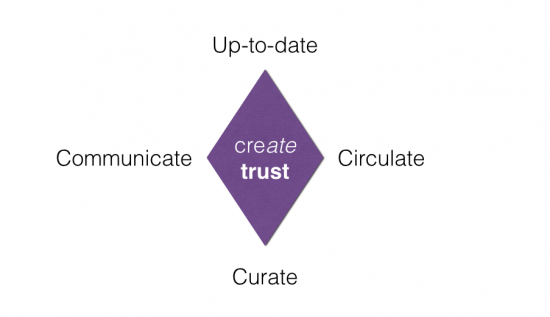In any version I have of the ideal salesperson in the future, nothing will trump the strength of a great relationship. In an environment of deep flux, companies are grappling with the effects of the internet, an avalanche of new digital tools and devices, pressure on profits and rising costs of transportation and personnel, not to mention an ever more informed, demanding and vociferous customer. Nonetheless, especially in a B2B environment, cultivating a relationship is bound to remain one of, if not the most powerful sales “tools.” What’s the currency of a strong relationship? Trust.
So, that’s easy to write. The difficulty is garnering that trust. One of the mainstays is to show up consistently. In a cynical fashion, it might be called the “drip, drip” approach. Over time, even water drops will wear through the toughest of materials. However, in today’s rapid action, shareholder-thirsting environment, biding time is a certain luxury. And, depending on the culture, industry and the product lifecycle, it can feel more like waiting for Godot.
The best salesperson
No amount of coaching and training will replace the first and most important ingredient of a great salesperson: attitude. {Tweet this!} In today’s connected world, faced with a surfeit of information, an avalanche of new devices and tools and a evermore needy and demanding customer, the salesperson needs to have an unflagging desire to learn, an obsession with staying up-to-date and an unwavering ability to deliver on promises made (execution).
The salesperson’s road to trust
The first way to win trust is to know how to listen actively and earnestly. The second is demonstrating that you will use the information imparted with good intent (from the perspective of the customer). Thirdly, trust is earned by communicating regularly and with purpose. I think of the route to trust as a four-step process, with ever increasing levels of commitment.
4 steps to create trust
The four steps below inevitably demand digital savviness. The sales function in many organizations is one of the last to adopt the digital tools. However, I firmly believe that the best salespersons in the future will have a raised digital IQ, able to use the digital tools and the Internet to his/her advantage. {Tweet this} Each step requires a greater level of sophistication and commitment. To reach best in class will require an organization-wide effort.
- Up-to-date. Keeping up on the latest is a great way to provide value. The trick is being aware of the key interest points for the client. That’s one of the reasons why listening is so important up front. The typical topics on which to stay abreast are: industry-related, local (vicinity of the store or business) and specific interests (professional and personal). If every time the salesperson comes through the door bearing relevant and timely information, the customer will come to look at the salesperson’s visit through different eyes. Tools/services that can help the salesperson in this area include Google Alerts, Netvibes and Twitter. The key will be in the set-up to help sort out the wheat from the chaff.
- Circulate. In today’s social-media enhanced world, social sharing and participation can help gain favor. It shows you care. For example, you can participate in forums in which your customer participates, like a post on Facebook or retweet relevant tweets by your customer. The key is to do this with congruency. As a salesperson, one is acting in social circles as an individual working for an enterprise. It’s a clearer story when the individual is also the owner (ie an independent). IT, HR (training, G&Os) and legal should be kept in the loop if such a policy is generalized.

- Curate. Whereas being up-to-date is a question of staying abreast of what’s going on, curation is the art of selecting and disseminating the best information. Curation, in this respect, may be just a new term for old-fashioned intelligent filtering. However, in the internet-enabled world, curation involves the ability to identify, capture and re-publish content that can be shared. It’s a way of showing publicly your area of expertise. Tools or platforms on which to curate can be: Twitter (if the customer base is so inclined), Scoop.it or ContentGems (specific curation tools) or even Linkedin.
- Communicate / publish. If all of the above 3 terms are forms of communication, the fourth step is actually more about being the author. In this step, the salesperson is taking ownership of the content and distributing it. Examples of platforms that can be used to publish one’s own ideas range from the short form (Twitter, Weibo, WeChat, Snapchat) to images (Instagram, Pinterest, even Jelly) to longer form (Quora, Tumblr through to blog). The three keys to a successful publishing strategy: (a) craft a clear editorial line on theme about which the salesperson (or possibly salesteam) is knowledgeable and passionate; (b) create content that is aligned with who and where the customer is; and (c) plan the resources for a long-term journey.
While this post is typically aimed more at the B2B salesperson, there is plenty of scope for crossover into the B2C world, especially when we consider the luxury goods customers. Being the best salesperson can, of course, mean different things in different contexts. However, gaining trust to develop a strong relationship is vital for all customer-facing personnel and requires, in fine, that the entire organization is aligned behind those serving on the front line.
Your reactions?
—-
Eric Mellet and I co-wrote a white paper entitled, “The Brand University.” One of the necessary components of a modern brand university would be installing and instilling the above practices.











